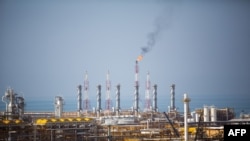Saudi Arabia, the United Arab Emirates, Bahrain, and Egypt have cut all ties with Qatar on June 5, apparently over the amicable relations the small, gas-rich emirate maintains with Iran.
Why is Qatar so keen to be on good terms with Iran?
One big reason is pure economics. Qatar and Iran share the world’s largest independent gas field beneath the waters of the Persian Gulf. The North Field, as Qatar calls it, provides almost all the emirate’s gas production and around 60 percent of its export revenues.
While Iran has remained largely cut off from foreign investments and technical assistance since its 1979 revolution, Qatar signed deals with big Western companies. Huge liquid gas plants were built in the tiny country, and went on to become one of the world’s biggest gas exporters.
Iran and Qatar hold the world's second- and third-largest natural gas reserves behind Russia, respectively. In 1969, during the reign of Mohammad Reza Shah Pahlavi, the two countries signed a demarcation agreement in the Persian Gulf.
The undersea gas field covers an area of 9,700 square kilometers, of which 3,700 square kilometers (South Pars) are in Iranian territorial waters and 6,000 square kilometers (North Dome) are in Qatari territorial waters.
For the past two decades, Iran has struggled to develop South Pars and mimic Qatar’s success, finding it difficult to attract any viable partners. China, which promised to help develop South Pars, remained aloof and inactive until Iran called off the deal in 2012.
In January 2014, Qatar offered Iran help in developing South Pars. As Iran was immersed in its nuclear negotiations with global powers, Qatar was concerned a big Iranian push to increase production would follow.
If this were attempted in a haphazard way, the entire undersea gas field could be put at risk. Therefore, it would benefit the Qatar to help its bigger neighbor increase production in an efficient manner.
“After Iran signed the nuclear deal, this has opened the door for us to help them with making more use of South Pars, and the plan is to give them advice on technology and exploring the geology of the field,” a Qatar Petroleum source told Reuters at the time.
When Hassan Rouhani was elected president in 2013, contacts and talks began between the two countries aimed at boosting cooperation in gas exploration and production. Rouhani’s oil minister, Mohammad Javad Zanganeh, indicted soon after the election that the two countries wanted to cooperate to boost production. It is more likely that the desire for cooperation first came from Rouhani’s government, which was elected during crippling international sanctions and felt pressured to improve Iran’s chances of increasing fossil fuel exports and revenues.
“We have established channels of communications and established teams … between the two countries,” Qatar’s energy minister told Reuters in December 2013.
It is a different story, however, how much practical help Qatar can actually provide. Most of its own gas technology belongs to big oil companies, and Qatar would need their cooperation if it wanted to help Iran.
There is no doubt Qatar has been playing a delicate balancing act between Iran on the one hand and its Gulf Arab neighbors on the other.
In January 2016, when the Saudi Embassy was attacked and ransacked in Tehran, Riyadh severed its diplomatic relations with Tehran. Other Gulf nations followed by downgrading relations with Iran. Qatar was the last to join the other Arab nations by recalling its ambassador from Tehran.
However, as it appears now, Qatar’s solidarity with Saudi Arabia has waned and Iran and Qatar seem to be on good terms with one another again -- much to the irritation of Riyadh, which has become increasingly more intolerant of Iranian meddling in the region, especially in Yemen.







